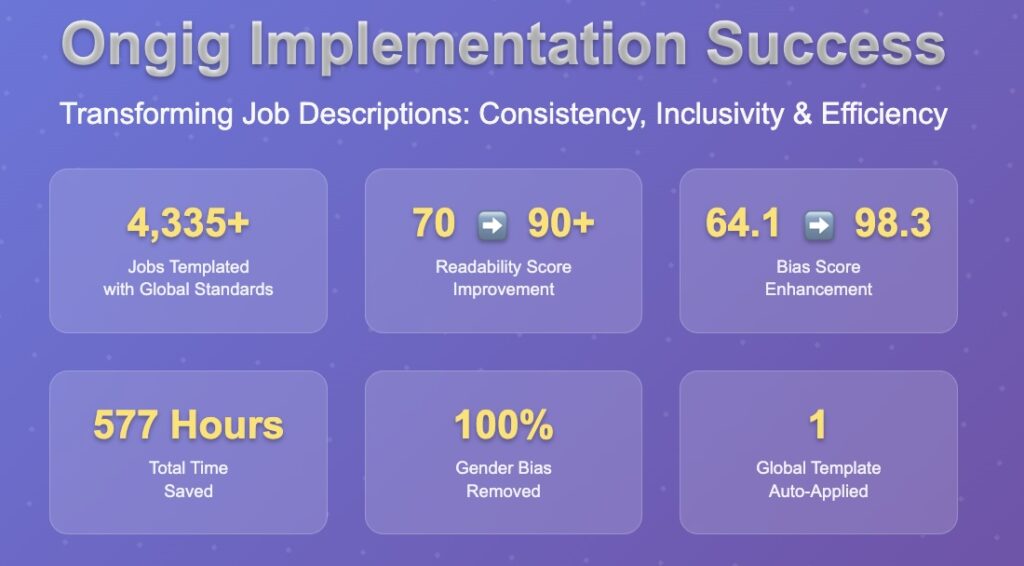- 16 Helpful Career Site Self-Service Tools for You - December 18, 2025
- Last Week I Had a Viral LinkedIn Post — But Why? (And What TA Folks Can Learn From It) - December 8, 2025
- Job Description Process Improvement: How One Workflow Fix Saved 1,200 JDs from Chaos - December 4, 2025
One person. Under 10 team members. More than 4,300 live job descriptions to fix.
If that sounds impossible, you’re not alone. But one Sr. Talent Program Advisor at a major healthcare organization pulled it off (with help from Ongig).
Meet the Team
This wasn’t a massive team of writers or a marketing army. The core players were:
- Sr. Talent Program Advisor (project lead)
- TA Program Advisors
- Recruitment Marketing Analyst
- Recruitment Marketing Media Consultant
- HR Managers
The mission? Rewrite, template, and standardize 4,300+ job descriptions across the organization—all while keeping daily recruiting work going.
The Job Description Problem
Over time, their job descriptions had become a mix of outdated formatting, inconsistent sections, and subtle gender bias. Some jobs lacked critical info (like Essential Functions or Success Factors), others had clunky intros that didn’t speak to the candidate. And many had formatting that didn’t play nice with their ATS or their career site.
The team knew they needed to fix it, but they didn’t have months to manually open and rewrite thousands of job descriptions from scratch. They had one global template and one special projects template. That’s it.
How Ongig Helped

They rolled out Ongig with a focus on job description optimization. Specifically consistency, inclusivity, readability, and time savings.
Key Outcomes:
- 4,335+ jobs standardized using a single global template (formatting, structure, SEO)
- Readability scores: improved from 70 ➡️ 90+
- Bias score: jumped from 64.1 ➡️ 98.3
- Time to review: cut from 30+ minutes (sometimes hours) ➡️ under 7 minutes
Ongig’s “unmatched content” alerts flagged only the 20% of postings with issues (~867 jobs), so the team avoided reviewing every single JD.
ROI Snapshot:
- 577 hours saved (the equivalent of 14+ full work weeks)
- Productivity value: $17K – $58K, depending on role; ~$30K is a conservative estimate
Why This Matters (Especially in Healthcare)
In a healthcare org, job descriptions aren’t just job ads; they’re regulatory documents, internal alignment tools, and first impressions for every candidate. Inconsistent or non-compliant language isn’t just a branding issue; it can be a legal one.
And with a small team, the TA leaders didn’t have hours to spend reviewing cycles between departments or rewriting a JD every time a new requisition opened. The ability to create, flag, and fix JDs fast made their jobs easier—and protected the org from risk.
The Ongoing Impact
The project wasn’t a one-time rewrite. It was the start of a process they could keep using. Jobs now go live with the global template by default. Ongig’s tools keep things compliant and consistent, even when hiring managers or recruiters try to “customize” postings in Taleo.
Next, they’re looking at syncing templates automatically with Taleo, using AI to create new JDs from scratch, and building out even more filterable custom fields to meet department-level needs. All without growing the team.
Why I Wrote This
If you’re in talent acquisition—especially in healthcare—you probably know the pain of trying to keep job descriptions clean, compliant, and candidate-friendly with limited resources.
At Ongig, we make job description optimization simple. Whether you’ve got 400 or 4,000+ JDs, we’ll help you rewrite, flag issues, and save hours per job—just like we did here.
Request a demo, and let’s fix your job postings for good.
FAQs
What is job description optimization?
It’s the process of making JDs more inclusive, readable, and structured using consistent templates, SEO best practices, and bias reduction tools.
How long does it take to optimize a job description?
With Ongig, under 7 minutes per JD—compared to 30+ minutes or hours with manual processes.
Can Ongig work for small TA teams?
Yes. This healthcare org did it with under 10 people. The key is automation and templates, not headcount.
Do we need multiple templates?
Nope. This team used just 1 global template and 1 for special projects. Simplicity is scalable.
Does Ongig support Taleo and other ATS integrations?
Absolutely. We support syncing with Taleo and other major ATSs to make rollout seamless.
